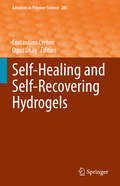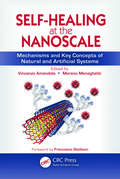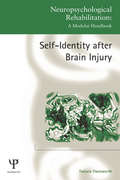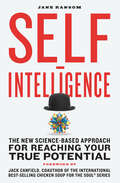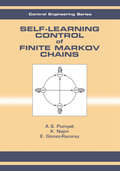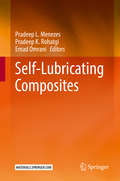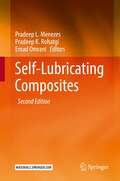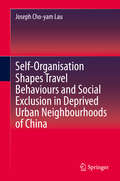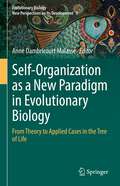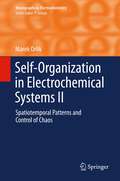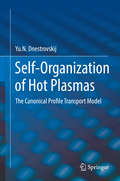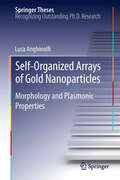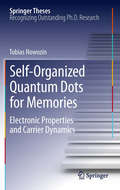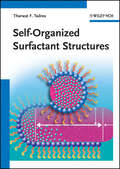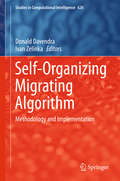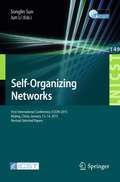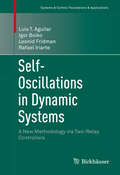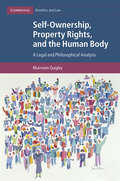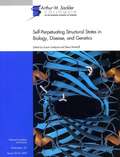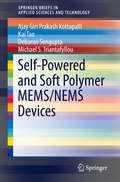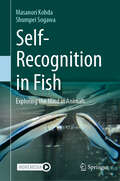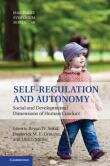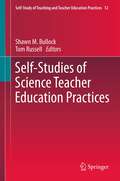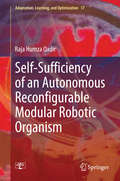- Table View
- List View
Self-Healing and Self-Recovering Hydrogels (Advances in Polymer Science #285)
by Oguz Okay Costantino CretonThis volume covers experimental and theoretical advances on the relationship between composition, structure and macroscopic mechanical properties of novel hydrogels containing dynamic bonds. The chapters of this volume focus on the control of the mechanical properties of several recently discovered gels with the design of monomer composition, chain architecture, type of crosslinking or internal structure. The gels discussed in the different chapters have in common the capability to dissipate energy upon deformation, a desired property for mechanical toughness, while retaining the ability to recover the properties of the virgin material over time or to self-heal when put back in contact after fracture. Some chapters focus on the synthesis and structural aspects while others focus on properties or modelling at the continuum or mesoscopic scale. The volume will be of interest to chemists and material scientists by providing guidelines and general structure-property considerations to synthesize and develop innovative gels tuned for applications. In addition it will provide physicists with a better understanding of the role of weak interactions between molecules and physical crosslinking on macroscopic dissipative properties and self-healing or self-recovering properties.
Self-Healing at the Nanoscale: Mechanisms and Key Concepts of Natural and Artificial Systems
by Vincenzo Amendola Moreno MeneghettiA complete panorama of self-healing strategies, Self-Healing at the Nanoscale: Mechanisms and Key Concepts of Natural and Artificial Systems focuses on the development of new nanoscale self-healing systems, from general concepts to physical chemical mechanisms. With a special emphasis on key concepts, strategies, and mechanisms at the atomic, molec
Self-Identity after Brain Injury (Neuropsychological Rehabilitation: A Modular Handbook)
by Tamara OwnsworthAn injury to the brain can affect virtually any aspect of functioning and, at the deepest level, can alter sense of self or the essential qualities that define who we are. In recent years, there has been a growing body of research investigating changes to self in the context of brain injury. Developments in the cognitive and social neurosciences, psychotherapy and neurorehabilitation have together provided a rich perspective on self and identity reformation after brain injury. This book draws upon these theoretical perspectives and research findings to provide a comprehensive account of the impact of brain injury on self-identity. The second half of this book provides an in-depth review of clinical strategies for assessing changes in self-identity after brain injury, and of rehabilitation approaches for supporting individuals to maintain or re-establish a positive post-injury identity. The book emphasizes a shift in clinical orientation, from a traditional focus on alleviating impairments, to a focus on working collaboratively with people to support them to re-engage in valued activities and find meaning in their lives after brain injury. Self-Identity after Brain Injury is the first book dedicated to self-identity issues after brain injury which integrates theory and research, and also assessment and intervention strategies. It will be a key resource to support clinicians and researchers working in brain injury rehabilitation, and will be of great interest to researchers and students in clinical psychology, neuropsychology, and allied health disciplines.
Self-Intelligence: The New Science-Based Approach for Reaching Your True Potential
by Jane Ransom“Count yourself lucky to have found this book. It contains some of the most fascinating information and material you will ever read.” —Jack Canfield, New York Times–bestselling author of The Success PrinciplesSelf-Intelligence is the self-help book for people who long to transform their lives and who trust only proven scientific tools, but also prefer page-turners to dry prose.Cutting-edge brain science meets superb storytelling as readers learn proven techniques to break through inner gridlock, sustain high performance, and achieve their dreams. All of this is possible due to neuroplasticity, the revolutionary discovery that we can literally re-form our brains by strategically choosing our thoughts, actions, and experiences.First came emotional intelligence, then came social intelligence. Here, at last, Self-Intelligence provides the big picture, incorporating the latest research from diverse scientific fields. Mental coach and transformational trainer Jane Ransom lays out for you the new Self-Intelligence™ model, which she has used to help countless clients achieve the positive change they previously found impossible.You’ll be uplifted, motivated to move forward, and simply fascinated. The author, who also is a master hypnotist, devotes a riveting chapter to the art and science of hypnosis. Throughout the book, she shares intriguing behind-the-curtain glimpses of its applications.By following the easy, clear precepts of Self-Intelligence, you can finally achieve your true potential and take the scientific short-cuts to greater success. You’ll be empowered to avert old obstacles and achieve tangible goals.“Entertaining and erudite, Self-Intelligence busts self-help myths while providing scientific tools to help ordinary people achieve extraordinary results.” —John J. Ratey, MD, Harvard Medical School professor and author of A User’s Guide to the Brain
Self-Learning Control of Finite Markov Chains
by A.S. Poznyak Kaddour Najim E. Gomez-RamirezPresents a number of new and potentially useful self-learning (adaptive) control algorithms and theoretical as well as practical results for both unconstrained and constrained finite Markov chains-efficiently processing new information by adjusting the control strategies directly or indirectly.
Self-Lubricating Composites
by Pradeep K. Rohatgi Pradeep L. Menezes Emad OmraniIn most tribological applications, liquid or grease based lubricants are used to facilitate the relative motion of solid bodies to minimize friction and wear between interacting surfaces. The challenges for liquid lubricants arise in extreme environmental conditions, such as very high or low temperatures, vacuum, radiation, and extreme contact pressure. At these conditions, solid lubricants may be the alternative choice which can help to decrease friction and wear without incorporating liquid lubricants. Challenges with solid lubricants are to maintain a continuous supply of solid lubricants on the contact surfaces to act as lubricous layer between two sliding surfaces. Such a continuous supply of solid lubricant is more easily maintained in the case of liquid lubricants when compared to solid lubricants. The most innovative development to ensure a continuous supply of solid lubricant to the contact surface during sliding is to introduce solid lubricant as reinforcement into the matrix of one of the sliding components. Composite materials are engineered or naturally occurring materials which contain two or more distinct constituents with significantly different chemical, physical and mechanical properties. Composites consist of reinforcement and matrix (metal, polymer and ceramics). Among various reinforcements, recent emerging material, solid lubricant, is found to have many favorable attributes such as good self-lubricant property. Self‐lubrication is the ability of material to transfer embedded solid lubricants to the contact surface to decrease wear rate and friction in the absence of an external lubricant. Self-lubricating metal matrix composites (SLMMCs) are an important category of engineering materials that are increasingly replacing a number of conventional materials in the automotive, aerospace, and marine industries due to superior tribological properties. In SLMMCs, solid lubricant materials including carbonous materials, molybdenum disulfide (MoS2), and hexagonal boron nitride (h-BN) are embedded into the metal matrices as reinforcements to manufacture a novel material with attractive self-lubricating properties. Several studies have been investigated the tribological properties of self-lubricating materials. This book fills that gap to have a reference book about self-lubricating materials and their properties to help scientists, engineers, and industries. This book will try to discuss technically about self-lubricating materials and their properties and the applications for industries. The chapters will be written by authoritative expertise in the field. Additionally, this book will demonstrate fundamental study and most advanced innovations in self-lubricating materials as regards to friction and wear. The chapters also include tribological properties of composites and coatings and some practical application of self-lubricating materials.
Self-Lubricating Composites
by Pradeep K. Rohatgi Pradeep L. Menezes Emad OmraniIn most tribological applications, liquid or grease based lubricants are used to facilitate the relative motion of solid bodies to minimize friction and wear between interacting surfaces. The challenges for liquid lubricants arise in extreme environmental conditions, such as very high or low temperatures, vacuum, radiation, and extreme contact pressure. At these conditions, solid lubricants may be the alternative choice which can help to decrease friction and wear without incorporating liquid lubricants. Challenges with solid lubricants are to maintain a continuous supply of solid lubricants on the contact surfaces to act as lubricous layer between two sliding surfaces. Such a continuous supply is more easily maintained in the case of liquid lubricants when compared to solid lubricants. The most innovative development to ensure a continuous supply of solid lubricant to the contact surface during sliding is to introduce solid lubricant as reinforcement into the matrix of one of the sliding components. Composite materials are engineered or naturally occurring materials which contain two or more distinct constituents with significantly different chemical, physical and mechanical properties. Composites consist of reinforcement and matrix (metal, polymer and ceramics). Among various reinforcements, recent emerging material, solid lubricant, is found to have many favorable attributes such as good lubrication property. Self‐lubrication is the ability of a material to provide lubrication to the contact surface to decrease friction and wear rate in the absence of an external lubricant by transferring embedded solid lubricants in the composite to the interface. Self-lubricating composites (SLCs) are an important category of engineering materials that are increasingly replacing a number of conventional materials in the automotive, aerospace, and marine industries due to superior tribological properties. In SLCs, solid lubricant materials, including carbonous materials, molybdenum disulfide (MoS2), and hexagonal boron nitride (h-BN) are embedded into the matrices as reinforcements to manufacture a novel material with attractive self-lubricating properties. Several studies have been investigated the tribological properties of self-lubricating materials. This book fills that gap to have a reference book about self-lubricating materials and their properties to help scientists, engineers, and industries. This book discusses mechanisms of self-lubricating materials, self-lubricating properties and the applications for industries. The chapters will be written by authoritative expertise in the field. Additionally, this book will demonstrate fundamental study and most advanced innovations in self-lubricating materials as regards to friction and wear. The chapters also include tribological properties of composites and coatings and some practical applications of self-lubricating materials.
Self-Organisation Shapes Travel Behaviours and Social Exclusion in Deprived Urban Neighbourhoods of China
by Joseph Cho-yam LauThis book investigates the influence of self-organisation processes on the commuting of the poor workers in urban China. It suggests a new approach to investigate and measure individual access, and it argues that dynamic interactions between individual action and social structure influence individual’s access to transport, which cannot be measured using other traditional accessibility approaches.The overwhelming majority of models in transport research assume that socio-economic factors and the built-environment influence the accessibility of transport for individuals. This book provides evidence that individual decision-makings and actions are also vital factors to bring out changes in accessibility. Further, the study adopts a self-organisation process and structuration theory to illustrate that a significant proportion of travel problems of migrants are rooted in the interaction between actions and social structures. Any change in migrants’ actions or social structures in the self-organisation process would result in the production of complex and spontaneous travel behaviour. The self-organisation approach presented provides a new approach for urban transport planning in the future, particularly on the investigation of the accessibility of disadvantaged social groups. By using the social theories, transport research can have an effect on commuting behaviour and to improve poor workers’ quality of life.
Self-Organization as a New Paradigm in Evolutionary Biology: From Theory to Applied Cases in the Tree of Life (Evolutionary Biology – New Perspectives on Its Development #5)
by Anne Dambricourt MalasséThe epistemological synthesis of the various theories of evolution, since the first formulation in 1802 with the transmission of the inherited characters by J.B. Lamarck, shows the need for an alternative synthesis to that of Princeton (1947). This new synthesis integrates the scientific models of self-organization developed during the second half of the 20th century based on the laws of physics, thermodynamics, and mathematics with the emergent evolutionary problematics such as self-organized memory.This book shows, how self-organization is integrated in modern evolutionary biology. It is divided in two parts: The first part pays attention to the modern observations in paleontology and biology, which include major theoreticians of the self-organization (d’Arcy Thompson, Henri Bergson, René Thom, Ilya Prigogine). The second part presents different emergent evolutionary models including the sciences of complexity, the non-linear dynamical systems, fractals, attractors, epigenesis, systemics, and mesology with different examples of the sciences of complexity and self-organization as observed in the human lineage, from both internal (embryogenesis-morphogenesis) and external (mesology) viewpoints.
Self-Organization in Electrochemical Systems I
by Marek OrlikThis is the first of two volumes offering the very first comprehensive treatise of self-organization and non-linear dynamics in electrochemical systems. The second volume covers spatiotemporal patterns and the control of chaos. The content of both volumes is organized so that each description of a particular electrochemical system is preceded by an introduction to basic concepts of nonlinear dynamics, in order to help the reader unfamiliar with this discipline to understand at least fundamental concepts and the methods of stability analysis. The presentation of the systems is not limited to laboratory models but stretches out to real-life objects and processes, including systems of biological importance, such as neurons in living matter. Marek Orlik presents a comprehensive and consistent survey of the field.
Self-Organization of Hot Plasmas
by Yu. N. DnestrovskijIn this monograph the author presents the Canonical Profile Transport Model or CPTM as a rather general mathematical framework to simulate plasma discharges. The description of hot plasmas in a magnetic fusion device is a very challenging task and many plasma properties still lack a physical explanation. One important property is plasma self-organization. It is very well known from experiments that the radial profile of the plasma pressure and temperature remains rather unaffected by changes of the deposited power or plasma density. The attractiveness of the CPTM is that it includes the effect of self-organization in the mathematical model without having to recur to particular physical mechanisms. The CPTM model contains one dimensional transport equations for ion and electron temperatures, plasma density and toroidal rotation velocity. These equations are well established and in fact are essentially a reformulation the laws of energy, particle and momentum conservation. But the expressions for the energy and particle fluxes, including certain critical gradients, are new. These critical gradients can be determined using the concept of canonical profiles for the first time formulated in great detail in the book. This concept represents a totally new approach to the description of transport in plasmas. Mathematically, the canonical profiles are formulated as a variational problem. To describe the temporal evolution of the plasma profiles, the Euler equation defining the canonical profiles is solved together with the transport equations at each time step. The author shows that in this way it is possible to describe very different operational scenarios in tokamaks (L-Mode, H-Mode, Advanced Modes, Radiating Improved Modes etc. . . ), using one unique principle. The author illustrates the application of this principle to the simulation of plasmas on leading tokamak devices in the world (JET, MAST, T-10, DIII-D, ASDEX-U, JT-60U). In all cases the small differences between the calculated profiles for the ion and electron temperatures and the experimental is rather confirm the validity of the CPTM. In addition, the model also describes the temperature and density pedestals in the H-mode and non steady-state regimes with current and density ramp up. The proposed model therefore provides a very useful mathematical tool for the analysis of experimental results and for the prediction of plasma parameters in future experiments.
Self-Organized Arrays of Gold Nanoparticles
by Luca AnghinolfiThis thesis addresses the fabrication and investigation of the optical response of gold nanoparticle arrays supported on insulating LiF(110) nanopatterned substrates. Motivated by the discovery of the intriguing effects that arise when electromagnetic radiation interacts with metallic nanostructures, the thesis focuses on the application of bottom-up approaches to the fabrication of extended-area plasmonic nanostructures, and the optimization of their optical response. By developing a sophisticated effective-medium model and comparing the experimental findings with model calculations, the author explores the role of the interparticle electromagnetic coupling and array dimensionality on the collective plasmonic behavior of the array, giving insights into the physical mechanisms governing the optical response.
Self-Organized Criticality
by Henrik Jeldtoft JensenSelf-organized criticality (SOC) is based upon the idea that complex behavior can develop spontaneously in certain multi-body systems whose dynamics vary abruptly. This book is a clear and concise introduction to the field of self-organized criticality, and contains an overview of the main research results. The author begins with an examination of what is meant by SOC, and the systems in which it can occur. He then presents and analyzes computer models to describe a number of systems, and he explains the different mathematical formalisms developed to understand SOC. The final chapter assesses the impact of this field of study, and highlights some key areas of new research. The author assumes no previous knowledge of the field, and the book contains several exercises. It will be ideal as a textbook for graduate students taking physics, engineering, or mathematical biology courses in nonlinear science or complexity.
Self-Organized Quantum Dots for Memories
by Tobias NowozinToday's semiconductor memory market is divided between two types of memory: DRAM and Flash. Each has its own advantages and disadvantages. While DRAM is fast but volatile, Flash is non-volatile but slow. A memory system based on self-organized quantum dots (QDs) as storage node could combine the advantages of modern DRAM and Flash, thus merging the latter's non-volatility with very fast write times. This thesis investigates the electronic properties of and carrier dynamics in self-organized quantum dots by means of time-resolved capacitance spectroscopy and time-resolved current measurements. The first aim is to study the localization energy of various QD systems in order to assess the potential of increasing the storage time in QDs to non-volatility. Surprisingly, it is found that the major impact of carrier capture cross-sections of QDs is to influence, and at times counterbalance, carrier storage in addition to the localization energy. The second aim is to study the coupling between a layer of self-organized QDs and a two-dimensional hole gas (2DHG), which is relevant for the read-out process in memory systems. The investigation yields the discovery of the many-particle ground states in the QD ensemble. In addition to its technological relevance, the thesis also offers new insights into the fascinating field of nanostructure physics.
Self-Organized Surfactant Structures (Topics In Colloid And Interface Science (vch) Ser.)
by Tharwat F. TadrosHighlighting recent developments as well as future challenges, this series of volumes covers such topics as emulsions, nano-emulsions, nano-dispersions and novel techniques for their investigation. It also considers the fundamental approach in areas such as controlled release, drug delivery and various applications of nanotechnology.
Self-Organizing Migrating Algorithm
by Ivan Zelinka Donald DavendraThis book brings together the current stateof-the-art research in Self Organizing Migrating Algorithm (SOMA) as a novelpopulation-based evolutionary algorithm, modeled on the predator-preyrelationship, by its leading practitioners. As the first ever book on SOMA, this book isgeared towards graduate students, academics and researchers, who are looking fora good optimization algorithm for their applications. This book presents themethodology of SOMA, covering both the real and discrete domains, and itsvarious implementations in different research areas. The easy-to-follow andimplement methodology used in the book will make it easier for a reader toimplement, modify and utilize SOMA.
Self-Organizing Networks
by Jun Li Songlin SunThis book constitutes the thoroughly refereed post-conference proceedings of the International ICST Conference on Self-Organizing Networks, ICSON 2015, held in January 2015 in Beijing, China. The 20 revised full papers presented were carefully reviewed and selected from 24 submissions and cover topics as resource allocation and management, signal processing and transmission, and multimedia service
Self-Oscillations in Dynamic Systems
by Igor Boiko Leonid Fridman Luis T. Aguilar Rafael IriarteThis monograph presents a simple and efficient two-relay control algorithm for generation of self-excited oscillations of a desired amplitude and frequency in dynamic systems. Developed by the authors, the two-relay controller consists of two relays switched by the feedback received from a linear or nonlinear system, and represents a new approach to the self-generation of periodic motions in underactuated mechanical systems. The first part of the book explains the design procedures for two-relay control using three different methodologies - the describing-function method, Poincaré maps, and the locus-of-a perturbed-relay-system method - and concludes with stability analysis of designed periodic oscillations. Two methods to ensure the robustness of two-relay control algorithms are explored in the second part, one based on the combination of the high-order sliding mode controller and backstepping, and the other on higher-order sliding-modes-based reconstruction of uncertainties and their compensation where Lyapunov-based stability analysis of tracking error is used. Finally, the third part illustrates applications of self-oscillation generation by a two-relay control with a Furuta pendulum, wheel pendulum, 3-DOF underactuated robot, 3-DOF laboratory helicopter, and fixed-phase electronic circuits. Self-Oscillations in Dynamic Systems will appeal to engineers, researchers, and graduate students working on the tracking and self-generation of periodic motion of electromechanical systems, including non-minimum-phase systems. It will also be of interest to mathematicians working on analysis of periodic solutions.
Self-Ownership, Property Rights, and the Human Body: A Legal And Philosophical Analysis (Cambridge Bioethics And Law #43)
by Muireann QuigleyHow ought the law to deal with novel challenges regarding the use and control of human biomaterials?<P><P> As it stands the law is ill-equipped to deal with these. Quigley argues that advancing biotechnology means that the law must confront and move boundaries which it has constructed; in particular, those which delineate property from non-property in relation to biomaterials. <P>Drawing together often disparate strands of property discourse, she offers a philosophical and legal re-analysis of the law in relation to property in the body and biomaterials. She advances a new defence, underpinned by self-ownership, of the position that persons ought to be seen as the prima facie holders of property rights in their separated biomaterials. <P>This book will appeal to those interested in medical and property law, philosophy, bioethics, and health policy amongst others.<P> Includes a robust discussion of self-ownership and provides a new perspective to the legal literature.<P> Brings together legal and philosophical scholarship in the area and enriches the discourse by taking a wider and more integrated view.<P> Discusses in-depth the legislative and common law background by covering a number of jurisdictions: England and Wales, Scotland, US, Canada and Australia.
Self-Perpetuating Structural States in Biology, Disease, and Genetics
by National Academy of ScienceThe National Academies Press (NAP)--publisher for the National Academies--publishes more than 200 books a year offering the most authoritative views, definitive information, and groundbreaking recommendations on a wide range of topics in science, engineering, and health. Our books are unique in that they are authored by the nation's leading experts in every scientific field.
Self-Powered and Soft Polymer MEMS/NEMS Devices (SpringerBriefs in Applied Sciences and Technology)
by Michael S. Triantafyllou Ajay Giri Kottapalli Kai Tao Debarun SenguptaThis book explores the fabrication of soft material and biomimetic MEMS sensors, presents a review of MEMS/NEMS energy harvesters and self-powered sensors, and focuses on the recent efforts in developing flexible and wearable piezoelectric nanogenerators. It also includes a critical analysis of various energy harvesting principles, such as electromagnetic, piezoelectric, electrostatic, triboelectric, and magnetostrictive. This multidisciplinary book is appropriate for students and professionals in the fields of material science, mechanical engineering, electrical engineering, and bioengineering.
Self-Recognition in Fish: Exploring the Mind in Animals
by Masanori Kohda Shumpei SogawaThis book describes the process of making the major breakthrough in the study of animal self-awareness using fish. The discovery led by the author&’s team, proving the mirror self-recognition ability of fish, is vividly documented as they share the process of making, testing and verifying hypotheses and developing further hypotheses. The clear experimental results demonstrate the remarkable self-awareness in animals, overturning the conventional view and providing a key to understanding the origin of human self-awareness. Starting from the current understanding of fish brains, individual recognition by its face, the following chapters introduce the series of the authors&’ research projects designed to understand mirror self-recognition (MSR) in animals. The sequence of the research into fish&’s MSR is documented, including how it started, the failures and successes, and the struggles. Additional tests carried out in response to various criticisms of the work have led to a re-examination of the research methods used prior to the author&’s work. The book then addresses the question of exactly when and how some fish recognize themselves in a mirror, exploring the self-awareness and the &“mind&”, in other word &“Eureka moment&” in fish. This book points out and overturns the contradictions in conventional wisdom based on anthropocentrism and hypotheses about the evolution of self-awareness, proposing a new hypothesis that the self-awareness of humans and fish will be homologous. The book takes readers on an engaging exploration of the scientific experiments and the remarkable discovery of animal intelligence.
Self-Regulation and Autonomy
by Ulrich Müller Bryan W. Sokol Frederick M. E. Grouzet Bryan W. Sokol Frederick M. E. GrouzetSelf-regulation and autonomy have emerged as key predictors of health and well-being in several areas of psychology. This timely volume brings together eminent scholars at the forefront of this research, which is taking place in disciplines including developmental psychology, developmental neuroscience, social psychology and educational psychology. The contributors present ideas and research findings on the development of self-regulation and autonomy, including their biological bases, antecedents and consequences. Editors Bryan W. Sokol, Frederick M. E. Grouzet and Ulrich Müller have shaped the volume's multidisciplinary perspective on self-regulation and autonomy to reflect the legacy of Jean Piaget, the trailblazing developmental psychologist whose work drew on a diverse body of research.
Self-Studies of Science Teacher Education Practices
by Tom Russell Shawn M. BullockPart of a vital Springer series on self-study practices in teaching and teacher education, this collection offers a range of contributions to the topic that embody the reflections of science teacher educators who have applied self-study methodology to their own professional development. The material recognizes the paradox that lies between classroom science and the education of science teachers: the disciplines of science are often perceived as a quest for right answers, an unintentional by-product of the classroom focus on right answers in student assessment in science. In contrast, the profession of teaching has few right answers and frequently involves the management of conflicting tensions. A dilemma thus arises in science teacher education of how to shift perspectives among student teachers from reductionist to more inclusive attitudes that are open to the mercurial realities of teaching. The self-studies presented here are unique, fresh and stimulating. They include the input of a beginning science teacher as well as science teacher educators from a range of backgrounds and varying levels of experience. In addition, the volume presents a truly international perspective on the issues, with authors hailing from five countries. Providing analysis at the leading edge of education theory, this collection will make fascinating reading for those teaching science--as well as those teaching science teachers.
Self-Sufficiency of an Autonomous Reconfigurable Modular Robotic Organism
by Raja Humza QadirThis book describes how the principle of self-sufficiency can be applied to a reconfigurable modular robotic organism. It shows the design considerations for a novel REPLICATOR robotic platform, both hardware and software, featuring the behavioral characteristics of social insect colonies. Following a comprehensive overview of some of the bio-inspired techniques already available, and of the state-of-the-art in re-configurable modular robotic systems, the book presents a novel power management system with fault-tolerant energy sharing, as well as its implementation in the REPLICATOR robotic modules. In addition, the book discusses, for the first time, the concept of "artificial energy homeostasis" in the context of a modular robotic organism, and shows its verification on a custom-designed simulation framework in different dynamic power distribution and fault tolerance scenarios. This book offers an ideal reference guide for both hardware engineers and software developers involved in the design and implementation of autonomous robotic systems.
